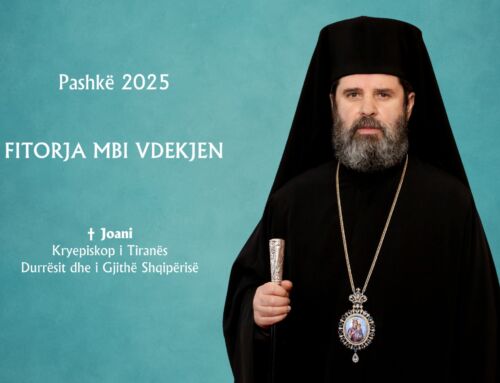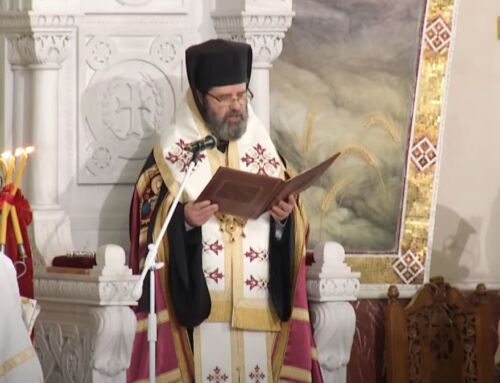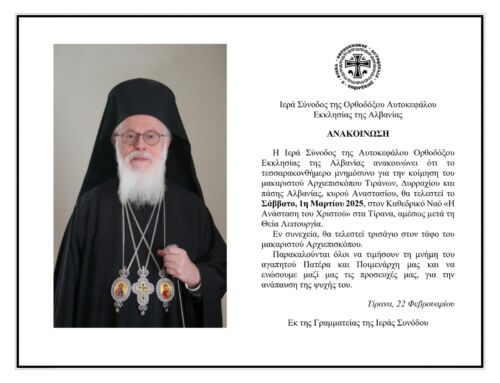.jpg) A unique exhibition of Byzantine and post-Byzantine codices was inaugurated in Tirana, Albania on May 3rd. It is the first time that such an exhibition was organized in our country and its goal was to introduce and to bring people closer to these treasures which originated from the Orthodox Church and have been strongly preserved by the clergy and the faithful through centuries. As it happened with the churches, the icons and the archives during communism, the codices survived the wild communist persecution and were safely stored by the state which still keeps them in its possession. A unique exhibition of Byzantine and post-Byzantine codices was inaugurated in Tirana, Albania on May 3rd. It is the first time that such an exhibition was organized in our country and its goal was to introduce and to bring people closer to these treasures which originated from the Orthodox Church and have been strongly preserved by the clergy and the faithful through centuries. As it happened with the churches, the icons and the archives during communism, the codices survived the wild communist persecution and were safely stored by the state which still keeps them in its possession. The organization of this event was made possible by the Center of Archives, the Greek Culture Foundation, the Cultural Foundation of the National Bank of Greece, the Orthodox Church of Albania and the contribution of Dr. Sali Berisha, the Prime Minister of Albania. Part of the organizing commission of the exhibition was Archimandrite, Fr. Justin Anthimiadhi and the MA historian paleographer Mr. Andrea Rëmbeci from the Orthodox Church of Albania.
The official opening of the exhibition took place in the afternoon of that day, at the venue of the Archive Head Offices. It was present the Prime Minister of Albania Dr. Sali Berisha, the Chief of the Assembly, Mrs. Jozefina Topalli, His Grace, Bishop Andoni, and other ministers, ambassadors, historians, intellectuals, and clergy. It was present also the philologist and paleographer, Mr. Agamemnon Celikas, the Director of Historical and Paleographical Archive of the Cultural Foundation of the National Bank of Greece, and the paleographer, Mr. Sokol Cunga.
.jpg) The ceremony started with a press conference in which the organizers emphasized the significance of the exhibition and the ways of its organization. Mrs. Nevila Nika, the director of the State Archive greeted the attendants stating in particular that the exhibition is like “a passport” for Albania and Albanians because in this exhibition one can find the deep roots of Albanian people by which we extend our vision towards the future”. The ceremony started with a press conference in which the organizers emphasized the significance of the exhibition and the ways of its organization. Mrs. Nevila Nika, the director of the State Archive greeted the attendants stating in particular that the exhibition is like “a passport” for Albania and Albanians because in this exhibition one can find the deep roots of Albanian people by which we extend our vision towards the future”. Then His Grace, Bishop Andoni, the speaker from the Orthodox Church read the greeting words of Archbishop Anastasios who could not be present at the ceremony. His Beatitude had written the following words, “The country of Albania has been very interested in taking part in the cultural creativity of the Byzantine Empire as well as in preserving the holy items for the civilization of the entire world”. “ The exponents that are being presented have been born by a common mother which is the Church; they were not created by indifferent artists as it happens nowadays, but they were created for worshiping purposes and they were used in religious life as a support for the people” (The entire speech is published above).
.jpg) Whereas, the Prime Minister of Albania, Dr. Sali Berisha greeted all those who were present in the ceremony and said that, “Such documents are an evidence of the Albanians’ contribution as a nation to Christianity and western civilization. In addition he stated that, “The purple codices as well as the other codices are a major and precious treasure that this nation has in its disposal since the early times. They are also a proof that the Albanians and the elite group in particular, preserved them and handed them from generation to generation”. Finally the Prime Minister assured the staff of the State Archive that “the government will make all the possible efforts to preserve and to develop further such priceless works which represent the spiritual, cultural and religious values of our nation”. Whereas, the Prime Minister of Albania, Dr. Sali Berisha greeted all those who were present in the ceremony and said that, “Such documents are an evidence of the Albanians’ contribution as a nation to Christianity and western civilization. In addition he stated that, “The purple codices as well as the other codices are a major and precious treasure that this nation has in its disposal since the early times. They are also a proof that the Albanians and the elite group in particular, preserved them and handed them from generation to generation”. Finally the Prime Minister assured the staff of the State Archive that “the government will make all the possible efforts to preserve and to develop further such priceless works which represent the spiritual, cultural and religious values of our nation”. The following day, on May 4th a scientific symposium took place in the venues of the State Archive about the exhibition.
Thoma Dhima |


